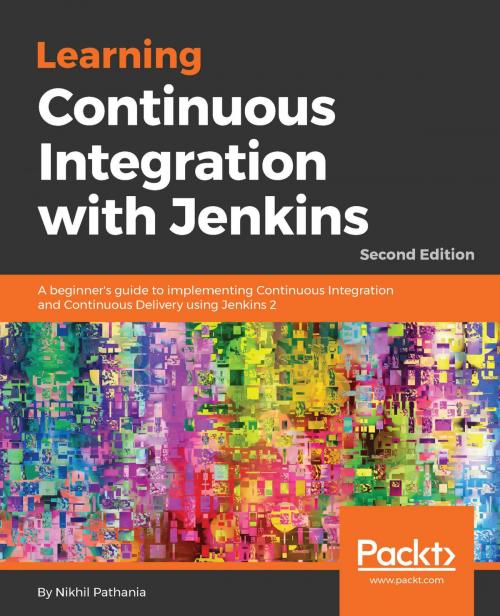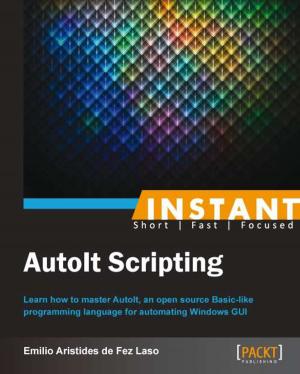Learning Continuous Integration with Jenkins
A beginner's guide to implementing Continuous Integration and Continuous Delivery using Jenkins 2, 2nd Edition
Nonfiction, Computers, Advanced Computing, Parallel Processing, Programming, Software Development, General Computing| Author: | Nikhil Pathania | ISBN: | 9781788475198 |
| Publisher: | Packt Publishing | Publication: | December 20, 2017 |
| Imprint: | Packt Publishing | Language: | English |
| Author: | Nikhil Pathania |
| ISBN: | 9781788475198 |
| Publisher: | Packt Publishing |
| Publication: | December 20, 2017 |
| Imprint: | Packt Publishing |
| Language: | English |
Speed up the software delivery process and software productivity using the latest features of Jenkins
Key Features
- Take advantage of a Continuous Integration and Continuous Delivery solution to speed up productivity and achieve faster software delivery
- See all the new features introduced in Jenkins 2.x, such as Pipeline as code, Multibranch pipeline, Docker Plugin, and more
- Learn to implement Continuous Integration and Continuous Delivery by orchestrating multiple DevOps tools using Jenkins
Book Description
In past few years, agile software development has seen tremendous growth. There is a huge demand for software delivery solutions that are fast yet flexible to numerous amendments. As a result, Continuous Integration (CI) and Continuous Delivery (CD) methodologies are gaining popularity.
This book starts off by explaining the concepts of CI and its significance in the Agile. Next, you'll learn how to configure and set up Jenkins in many different ways. The book exploits the concept of "pipeline as code" and various other features introduced in the Jenkins 2.x release to their full potential. We also talk in detail about the new Jenkins Blue Ocean interface and the features that help to quickly and easily create a CI pipeline. Then we dive into the various features offered by Jenkins one by one, exploiting them for CI and CD. Jenkins' core functionality and flexibility allows it to fit in a variety of environments and can help streamline the development process for all stakeholders. Next, you'll be introduced to CD and will learn how to achieve it using Jenkins.
Through this book's wealth of best practices and real-world tips, you'll discover how easy it is to implement CI and CD using Jenkins.
What you will learn
- Get to know some of the most popular ways to set up Jenkins
- See all the new features introduced in the latest Jenkins, such as pipeline as code, Multibranch pipeline, and more
- Manage users, projects, and permissions in Jenkins to ensure better security
- Leverage the power of plugins in Jenkins
- Learn how to create a CI pipeline using Jenkins Blue Ocean
- Create a distributed build farm using Docker and use it with Jenkins
- Implement CI and CD using Jenkins
- See the difference between CD and Continuous Deployment
- Understand the concepts of CI
Who this book is for
The book is for those with little or no previous experience with Agile or CI and CD. It’s a good starting point for anyone new to this field who wants to leverage the benefits of CI and CD to increase productivity and reduce delivery time. It’s ideal for Build and Release engineers, DevOps engineers, SCM (Software Configuration Management) engineers, developers, testers, and project managers. If you’re already using Jenkins for CI, you can take your project to the next level—CD.
Speed up the software delivery process and software productivity using the latest features of Jenkins
Key Features
- Take advantage of a Continuous Integration and Continuous Delivery solution to speed up productivity and achieve faster software delivery
- See all the new features introduced in Jenkins 2.x, such as Pipeline as code, Multibranch pipeline, Docker Plugin, and more
- Learn to implement Continuous Integration and Continuous Delivery by orchestrating multiple DevOps tools using Jenkins
Book Description
In past few years, agile software development has seen tremendous growth. There is a huge demand for software delivery solutions that are fast yet flexible to numerous amendments. As a result, Continuous Integration (CI) and Continuous Delivery (CD) methodologies are gaining popularity.
This book starts off by explaining the concepts of CI and its significance in the Agile. Next, you'll learn how to configure and set up Jenkins in many different ways. The book exploits the concept of "pipeline as code" and various other features introduced in the Jenkins 2.x release to their full potential. We also talk in detail about the new Jenkins Blue Ocean interface and the features that help to quickly and easily create a CI pipeline. Then we dive into the various features offered by Jenkins one by one, exploiting them for CI and CD. Jenkins' core functionality and flexibility allows it to fit in a variety of environments and can help streamline the development process for all stakeholders. Next, you'll be introduced to CD and will learn how to achieve it using Jenkins.
Through this book's wealth of best practices and real-world tips, you'll discover how easy it is to implement CI and CD using Jenkins.
What you will learn
- Get to know some of the most popular ways to set up Jenkins
- See all the new features introduced in the latest Jenkins, such as pipeline as code, Multibranch pipeline, and more
- Manage users, projects, and permissions in Jenkins to ensure better security
- Leverage the power of plugins in Jenkins
- Learn how to create a CI pipeline using Jenkins Blue Ocean
- Create a distributed build farm using Docker and use it with Jenkins
- Implement CI and CD using Jenkins
- See the difference between CD and Continuous Deployment
- Understand the concepts of CI
Who this book is for
The book is for those with little or no previous experience with Agile or CI and CD. It’s a good starting point for anyone new to this field who wants to leverage the benefits of CI and CD to increase productivity and reduce delivery time. It’s ideal for Build and Release engineers, DevOps engineers, SCM (Software Configuration Management) engineers, developers, testers, and project managers. If you’re already using Jenkins for CI, you can take your project to the next level—CD.















